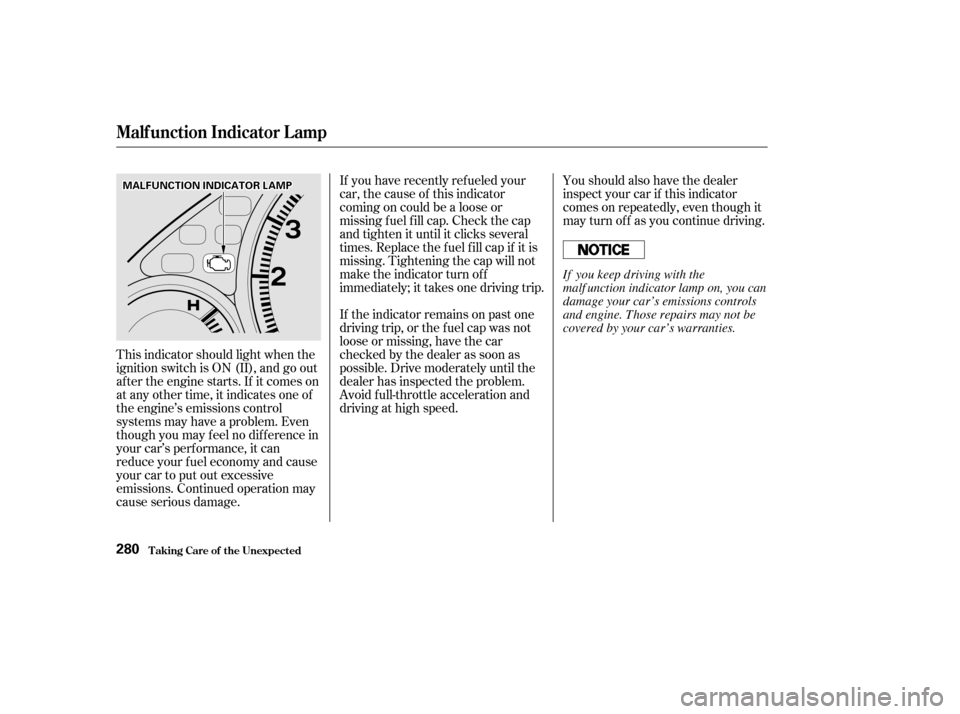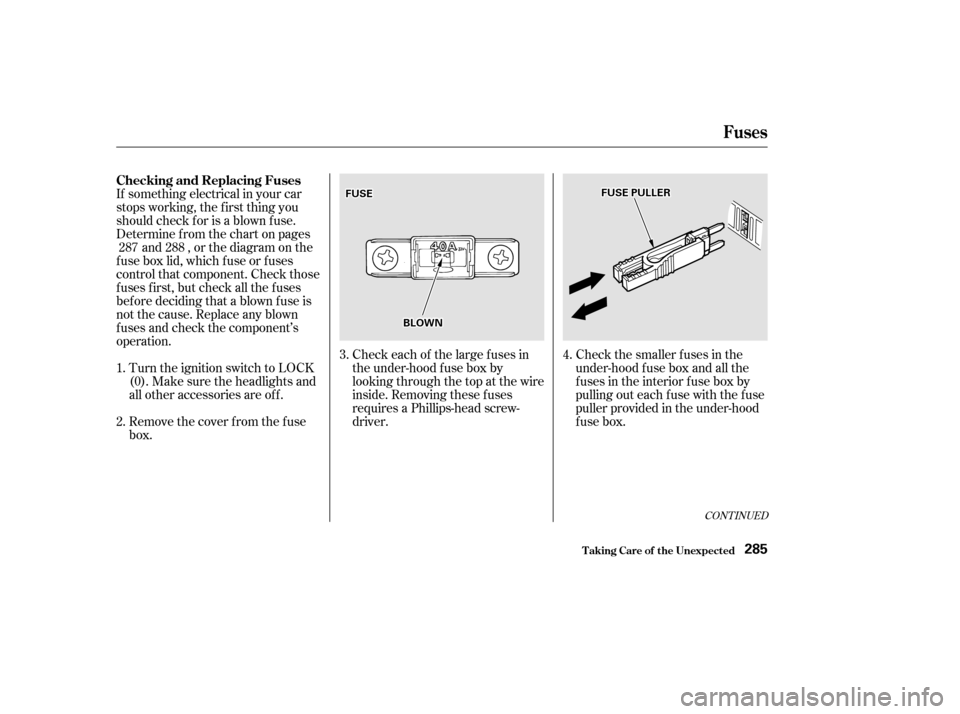Page 279 of 319

If you have recently ref ueled your
car, the cause of this indicator
coming on could be a loose or
missing f uel f ill cap. Check the cap
and tighten it until it clicks several
times. Replace the f uel f ill cap if it is
missing. Tightening the cap will not
make the indicator turn of f
immediately; it takes one driving trip.
If the indicator remains on past one
driving trip, or the f uel cap was not
loose or missing, have the car
checked by the dealer as soon as
possible. Drive moderately until the
dealer has inspected the problem.
Avoid full-throttle acceleration and
driving at high speed.Youshouldalsohavethedealer
inspect your car if this indicator
comes on repeatedly, even though it
may turn of f as you continue driving.
This indicator should light when the
ignition switch is ON (II), and go out
af ter the engine starts. If it comes on
at any other time, it indicates one of
the engine’s emissions control
systems may have a problem. Even
though you may f eel no dif f erence in
your car’s perf ormance, it can
reduce your f uel economy and cause
your car to put out excessive
emissions. Continued operation may
cause serious damage.
Malf unct ion Indicat or L amp
T aking Care of t he Unexpect ed280
MMAALLFFUUNNCCTTIIOONNIINNDDIICCAATTOORRLLAAMMPP
If you keep driving with the
malf unction indicator lamp on, you can
damage your car’s emissions controls
and engine. Those repairs may not be
covered by your car’s warranties.
Page 280 of 319
Your car has certain ‘‘readiness
codes’’ that are part of the on-board
diagnostics f or the emissions
systems. In some states, part of the
emissions testing is to make sure
these codes are set. If they are not
set, the test cannot be completed.
If your car’s battery has been
disconnected or gone dead, these
codes are erased. It takes several
days of driving under various
conditions to set the codes again.If possible, do not take your car f or a
state emissions test until the
readiness codes are set. To check if
they are set, turn the ignition ON (II),
but do not start the engine. The
Malf unction Indicator Lamp will
come on f or 20 seconds. If it then
goes of f , the readiness codes are set.
If it blinks 5 times, the readiness
codes are not set. See State
Emissions Testing on page .
301
Readiness Codes
Malf unct ion Indicat or L amp
T aking Care of t he Unexpect ed281
Page 281 of 319

�Î�Î
�Î�ÎSlow down by shif ting to a lower
gear, and pull to the side of the road
when it is saf e. Because of the
longer distance needed to stop, it is
hazardous to drive the car. You
should have it towed, and repaired as
soon as possible. (Seeon page .)
If you must drive the car a short
distance in this condition, drive
slowly and cautiously.
If it comes on at any other time, it
indicates a problem with the car’s
brake system. In most cases, the
problem is a low f luid level in the
brake f luid reservoir. Press lightly on
the brake pedal to see if it f eels
normal. If it does, check the brake
f luid level the next time you stop at a
service station (see page ). If the
fluid level is low, take the car to your
dealer and have the brake system
inspected f or leaks or worn brake
pads.
However, if the brake pedal does not
f eel normal, you should take
immediate action. Because of the
brake system’s dual-circuit design, a
problem in one part of the system
will still give you braking at two
wheels. You will f eel the brake pedal
go down much f arther bef ore the car
begins to slow down, and you will
have to press harder on the pedal.
The distance needed to stop will be
much longer.
The Brake System Indicator
normallycomesonwhenyouturn
the ignition switch ON (II). It is a
reminder to check the parking brake.
It comes on and stays lit if you do not
f ully release the parking brake.
223
289Emergency
Towing
Brake System Indicator
T aking Care of t he Unexpect ed282
UU..SS..iinnddiiccaattoorrsshhoowwnn
BBRRAAKKEESSYYSSTTEEMMIINNDDIICCAATTOORR
Page 284 of 319

If something electrical in your car
stops working, the f irst thing you
should check f or is a blown f use.
Determine f rom the chart on pagesand , or the diagram on the
fuse box lid, which fuse or fuses
control that component. Check those
f uses f irst, but check all the f uses
bef ore deciding that a blown f use is
not the cause. Replace any blown
f uses and check the component’s
operation.
Turn the ignition switch to LOCK
(0). Make sure the headlights and
all other accessories are off.
Remove the cover f rom the f use
box. Check each of the large f uses in
the under-hood f use box by
looking through the top at the wire
inside. Removing these f uses
requires a Phillips-head screw-
driver.
Check the smaller f uses in the
under-hood f use box and all the
fuses in the interior fuse box by
pulling out each f use with the f use
puller provided in the under-hood
fuse box.
3.
1. 2. 4.
287 288
CONT INUED
Checking and Replacing Fuses
Fuses
T aking Care of t he Unexpect ed285
FFUUSSEE
BBLLOOWWNN
FFUUSSEEPPUULLLLEERR
Page 286 of 319
�µ
�µ �µ
No.
CONT INUED
Amps. Circuits Protected
1 23456789
1011121314151617181920 20 A
15 A
7.5 A 20 A
10 A
15 A
15 A
20 A
10 A
40 A
40 A
40 A
40 A
40 A
15 A
20 A
15 A
80 A
40 A Condenser Fan
I. P. Lights, Exterior Lights
Interior Light
Cooling Fan
Hazard, Turn Signals
FI ECU
Horn, Brake Light
ABS F/S
Back Up
ABS Motor
Rear Defroster
Heater Motor
Power Window
Option
Lef t Headlight
Door Lock
Right Headlight
Not Used
Battery
Ignition 1
Spare Fuses
21 25
Fuses
T aking Care of t he Unexpect ed287
UNDER-HOOD FUSE BOX
Page 287 of 319
�µ�µ �µ �µ �µ �µ
�Î �Î
�Î
No. Amps. Circuits ProtectedNo. Amps. Circuits Protected
: On Canadian models
12345 15 A
20 A
10 A
10 A
Ignition Coil
LAF Heater
Daytime running lights
Alternator
Not Used 6789
1011 1213141516171819202122232425 7.5 A
20 A
7.5 A 10 A
7.5 A
7.5 A
7.5 A 10 A
10 A
15 A
15 A
7.5 A 20 A
20 A
20 A Power Window Relay
Moonroof
Accessory, Radio
SIDE SRS
Meter
ABS
Daytime running lights
SRS
Power Mirrors
(Security)
Not Used
Fuel Pump
Accessory Power Socket
Turn Signals
Front Wipers
Not Used
Front Right Power Window
Front Left Power Window
Not Used
Not Used
Fuses
T aking Care of t he Unexpect ed288
INTERIOR FUSE BOX
Page 289 of 319
If you decide to tow your car with all
f our wheels on the ground, make
sure you use a properly-designed and
attached tow bar. Prepare the car for
towing as described above, and leave
the ignition switch in Accessory (I)
so the steering wheel does not lock.
Make sure the radio and any items
plugged into the accessory power
socket are turned of f so they do not
rundownthebattery.
With the f ront wheels on the ground,
it is best to tow the car no farther
than 50 miles (80 km), and keep the
speedbelow35mph(55km/h).
If your car is equipped with a f ront
spoiler, remove it bef ore towing so it
is not damaged.
Emergency T owing
T aking Care of t he Unexpect ed290
Trying to lif t or tow your car by the
bumpers will cause serious damage.
The bumpers are not designed to
support the car’s weight.
The steering system can be damaged if
the steering wheel is locked. Leave the
ignition switch in Accessory (I), and
make sure the steering wheel turns
f reely bef ore you begin towing.
Page 290 of 319

Thediagramsinthissectiongive
you the dimensions and capacities of
your Honda, and the locations of the
identif ication numbers. It also
includes inf ormation you should
know about your vehicle’s tires and
emissions control systems.................
Identif ication Numbers . 292
................................
Specif ications . 294
DOT Tire Quality Grading
.............................
(U.S.Cars) .296
.................................
Treadwear . 296
......................................
Traction . 296
.............................
Temperature . 297
.........................
Oxygenated Fuels . 298
......
Driving in Foreign Countries . 299 .......................
Emissions Controls . 300
.....................
The Clean Air Act . 300
Crankcase Emissions Control
....................................
System . 300
Evaporative Emissions Control ....................................
System . 300
Onboard Ref ueling Vapor ................................
Recovery . 301
...
Exhaust Emissions Controls . 301
....................
PGM-FI System . 301
Ignition Timing Control
................................
System . 301
Three Way Catalytic ...........................
Converter . 301
....................
Replacement Parts . 301
..
Three Way Catalytic Converter . 302
..............
State Emissions Testing . 303
....
Testing of Readiness Codes . 303
T echnical Inf ormat ion
T echnical Inf ormation291